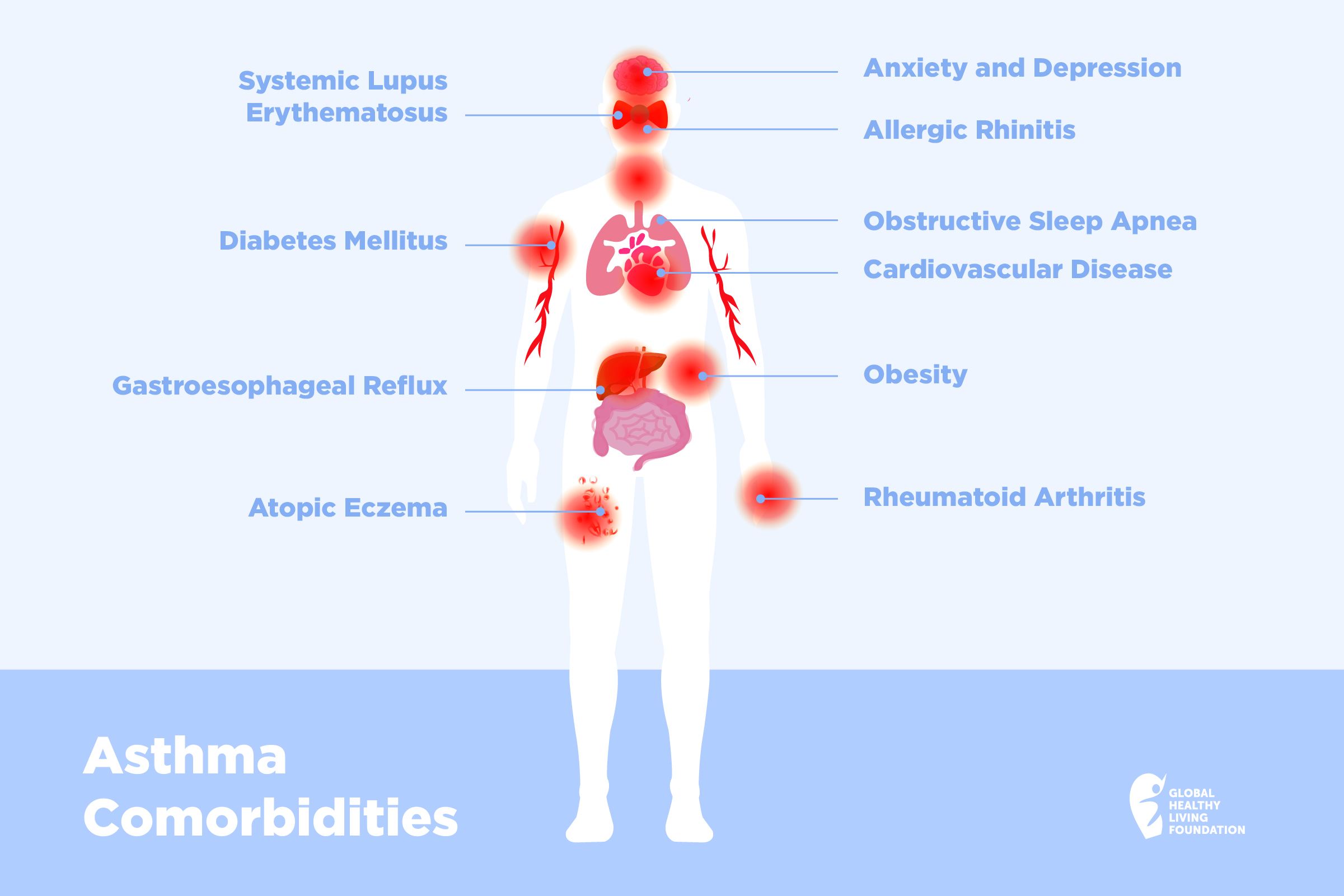Take charge of your asthma and associated conditions. Get tips on teaming up with specialists and confidently advocating for your care.
Personalizing Your Asthma Care
Personalizing Your Asthma Care
February 13, 2023
Nina Wasserman

Check out “Our Guide to Personalizing Your Asthma Care” for more information on this topic.
Having chronic asthma can be scary. You’re out shopping with your partner, dining at a restaurant, or sound asleep and you get triggered. It can start as a wheeze or a dry cough and quickly escalate to the point where no matter how deeply you draw in air, it’s just not enough. And when it gets to this point, you often have nowhere to turn but the emergency room.
Luckily, with new medications and shared decision-making, this scene can be avoided. You can work with your doctor to select treatment that will work specifically for you to control your asthma. Underpinning it all is the support you can get from your loved ones. They will be the ones walking with you on this journey step by step, day by day. They can help you keep tabs on whether or not your treatment regimen is working.
Maya David, a member of the LGBTQ+ community, is thankful for supportive friends who take their breathing issues under consideration whenever they meet up. As Maya David’s asthma worsened after they had COVID-19, their pulmonologist adjusted their medications. They now have their asthma under control.
If your primary care has been the emergency department or urgent care center, you are not getting the continuity of care you need. “The emergency department does not have time to take a long history, show you allergen avoidance, or educate you about new therapies like biologics,” says Dr. Barbara Yawn, MD, MSc, FAAFP, Adjunct Professor at the University of Minnesota. “They won’t notice if you are having frequent exacerbations or help keep you from the vicious cycle.”
If you do end up in the ER, Dr. Yawn says you need to follow up with your doctor afterward so they can keep track of your history and make sure your treatment is optimal.
Warning Signs
What signs do you need to watch out for if your asthma is out of control? According to the American Lung Association, if the following are happening to you, it’s time to get your asthma re-assessed:
- Wheezing, coughing, shortness of breath, or tightness in your chest on a daily basis
- Frequently waking with asthma
- Repeatedly going to the emergency department
- Missing work
- Stopping exercise
- Reducing daily activities
If you are experiencing any of these issues, your current asthma treatment is not doing its job. There are many new therapies and new combinations of therapies that you and your doctor can consider.
What’s the Best Asthma Treatment For You?
You don’t need to put up with sub-par treatment of your asthma.
For years, asthma care consisted only of inhaled corticosteroids. However, we know now that prolonged use of steroids can cause a host of issues, such as increased infections, according to the Mayo Clinic. “We are now trying to limit people’s exposure to steroids because even moderate doses over 20 years can have adverse effects,” says Dr. Yawn.
A 2022 study published in the Journal of Asthma and Allergy has found that long-term use of high doses of maintenance corticosteroids can be associated with more infections, osteoporosis, new onset or worsening of diabetes, depression, and cataracts. That’s why it’s important to make sure you are getting the right treatment.
The 2022 Global Initiative for Asthma (GINA) and the US National Heart Lung and Blood Institute (NHLBI) guidelines have taken into account the latest research and have established a step-by-step approach to treating your asthma.
The recommendations in the guidelines do differ based on the drugs currently available and approved in different countries. Since these are just guidelines, it’s important to seek advice from your doctor or other clinician, filling them in on the frequency of your asthma symptoms and exacerbations to ensure the best treatment for you, including any changes you need to make in your activities.
Steps One and Two
If you experience wheezing, shortness of breath, or chest tightness less than four or five days a week, you may be able to use asthma medications on an as-needed basis — just when you are having symptoms.
The U.S. recommendations suggest using low-dose inhaled corticosteroid (ICS) with a short acting bronchodilator like albuterol and currently the FDA is reviewing a new inhaler that will contain both. These as-needed regimens should reduce the risk of exacerbations that can send you to the emergency department.
Step Three
If you have asthma symptoms most days or have a tendency to wake up with asthma once or twice a week, the recommendations state that you should take a low-dose maintenance of an inhaled corticosteroid every day, adding the ICS and bronchodilator for quick relief or rescue therapy.
Step Four
If you have daily symptoms of asthma, you are awakened by asthma at least once a week, and you have low lung function, you should take a medium dose maintenance of an inhaled corticosteroid daily, again adding the quick reliever as needed. The U.S. guidelines suggest adding daily long acting bronchodilators may also be an option.
Step Five
If you continue to have daily symptoms and are awakened by asthma once or more each week, plus you have low lung function, it is recommended you add on a Long Acting Muscarinic Antagonist (LAMA).
Your doctor could also consider referring you for evaluation to see if you would benefit from a biologic, or injectable drug used to “calm down” the inflammation associated with asthma. There are several types of biologics that work to reduce the cytokines and cells that cause chronic inflammation in the lungs of people with asthma.
If your asthma is difficult to control or moderate to severe, you need to talk with your doctor to see whether biologics are right for you, says Dr. Yawn. Being on a biologic does not mean you stop your other medications.
And if a biologic is not working, you need to tell your doctor because there may be another that will work. “These may not work immediately,” she says. So you have to stay patient and may need to wait a month or two before considering a change in medication.
Adding a second medication such as a bronchodilator to the ICS can allow for a lower-dose of steroids, says Dr. Yawn. For allergic or exercise-induced asthma, leukotriene modifiers can lesson asthma symptoms. Leukotrienes are chemicals your body releases when you have an allergic reaction. These agents block the reaction. “Short course of oral steroids are often used for asthma exacerbations but we want to use them as little as possible,” says Dr. Yawn. “That is why getting the right daily or as-needed treatment is important.”
Maya takes a combination of an ICS inhaler twice a day, plus a leukotriene receptor antagonist (a pill), and an over-the-counter allergy medication at night. “What’s proven to be the most effective treatment so far,” Maya says, “is to learn to use the inhaler correctly — remembering to breathe deeply with each pump of the corticosteroids, and to hold my breath for ten seconds per inhalation.”
A 2021 study in the Journal of Allergy and Clinical Immunology in Practice recommends using an inhaler with a combination of a corticosteroid and the bronchodilator formoterol as both maintenance therapy and a rescue inhaler. The treatment, called Single Maintenance and Reliever Therapy (SMART), is meant for use in steps three and four in the GINA guidelines.
Assess, Adjust, Review, Repeat
As part of shared-decision making with your doctor, together you need to assess the severity of your asthma, adjust your medications accordingly, and periodically review your plan to make sure it is still working for you, says Dr. Yawn.
The possibilities can be confusing for people who have been on the same medication for years, so it is very important to discuss all your options with your doctor. Luckily, there are several assessment tools available to determine the severity of your asthma and whether your treatment plan is working.
- AIRQ: The Asthma Impairment Risk Questionnaire is a free, short self-assessment to score your asthma control. It can also be done during a visit with a health professional. Results are meant to be shared with your doctor.
- Asthma Control Questionnaire (ACQ): The ACQ is an assessment of symptoms and rescue bronchodilator use, that is part self-administered and part clinician-administered. The test measures from 0 (totally controlled) to 6 (severely uncontrolled).
- Asthma Control Test (ACT): A five-question self-administered test asking about your symptoms and your asthma’s impact on daily activities.
- Asthma APGAR Plus: A comprehensive clinician-administered test that has shown in studies to improve rates of asthma control.
Looking to the Future
“The next step in personalizing therapy is to think about endotypes, phenotypes, and genotypes,” says Dr. Yawn. Asthma is a disease of different phenotypes, or observable characteristics of the disease. As research progresses, treatment will be tailored to the different types, according to the American Academy of Allergy, Asthma and Immunology.
These phenotypes can include these types of asthma and more:
- Allergic
- Non-allergic
- Aspirin sensitive
- Severe
- Exercise-induced
- Neutrophilic
- Fixed obstruction
- Occupational
Endotypes define your type of asthma at a molecular level. The two basic types are Type 2 low and Type 2 high. According to a study in the Journal of Clinical Investigation, the endotype approach, which is still emerging, will improve the diagnosing, monitoring, and stratifying of people with asthma. Using genotypes, which are the genetic markers of asthma, is still in the very early stages of research.
Get Asthma Support
If you would like to receive emails about asthma support and education, please subscribe to the Global Healthy Living Foundation here.
This article was made possible with support from Amgen and AstraZeneca.
Agache I, et al. Precision medicine and phenotypes, endotypes, genotypes, regiotypes, and theratypes of allergic diseases. The Journal of Clinical Investigation. March 11, 2019. https://www.jci.org/articles/view/124611
Lugogo N, et al. Long-term use of maintenance systemic corticosteroids is associated with multiple adverse conditions in a large, real-world cohort of US adults with severe asthma. Journal of Asthma and Allergy. December 2022. https://www.dovepress.com/long-term-use-of-maintenance-systemic-corticosteroids-is-associated-wi-peer-reviewed-fulltext-article-JAA
Reddel H, et al. A practical guide to implementing SMART in asthma management. Journal of Allergy and Clinical Immunology in Practice. January 2022. DOI: 10.1016/j.jaip.2021.10.011
Yawn B, et al. Use of asthma APGAR tools in primary care practices: a cluster-randomized controlled trial. Annals of Family Medicine. March 16, 2018. DOI: 10.1370/afm.2179
Interview with Dr. Barbara Yawn, MD, MSc, FAAFP, Adjunct Professor at the University of Minnesota.
SUBSCRIBE TO GHLF
RELATED POST AND PAGES
_
Was this article helpful?
YesNo







